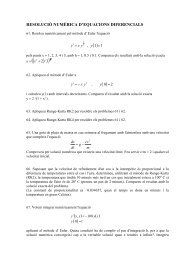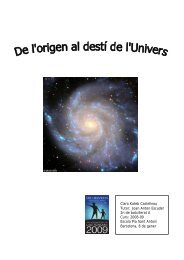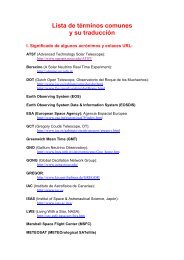Universitat de - Departament d'Astronomia i Meteorologia ...
Universitat de - Departament d'Astronomia i Meteorologia ...
Universitat de - Departament d'Astronomia i Meteorologia ...
Create successful ePaper yourself
Turn your PDF publications into a flip-book with our unique Google optimized e-Paper software.
50 Chapter 2. Multiwavelength approach to LS 5039<br />
2.4.5 EVN and MERLIN observations,<br />
confirmation of persistent relativistic radio jets<br />
The persistent radio emission of LS 5039 suggests that the jet is always present.<br />
With the aim to confirm this hypothesis, and also to <strong>de</strong>tect the jet at larger angular<br />
scales than those imaged with the previous Very Long Baseline Array (VLBA) mea-<br />
surements, we observed this microquasar with the European VLBI Network (EVN)<br />
and the Multi-Element Radio-Linked Interferometer Network (MERLIN).<br />
Observations and results<br />
We observed 13 LS 5039 simultaneously with the EVN 14 and MERLIN 15 on 2000<br />
March 1 (3:20–7:10 UT, MJD 51604.2) at 5 GHz. Single dish flux <strong>de</strong>nsity measure-<br />
ments were carried out with the MPIfR 100 m antenna in Effelsberg. We scheduled<br />
the observation introducing the phase-reference calibrator J1823−1228, the fringe-<br />
fin<strong>de</strong>r DA 193 and the flux <strong>de</strong>nsity calibrator 3C 286. Unfortunately, the phase-<br />
reference calibrator was not <strong>de</strong>tected and could not be used during the correlation.<br />
The EVN observations were performed with the array <strong>de</strong>scribed in Table 2.2.<br />
Data were recor<strong>de</strong>d in MkIV mo<strong>de</strong> with 2-bit sampling at 256 Mbps at left hand<br />
circular polarization, yielding a full bandwidth of 64 MHz (v6cm-256-8-2-L mo<strong>de</strong>).<br />
The data were correlated at the Joint Institute for VLBI in Europe (JIVE). An inte-<br />
gration time of 4 s was used. Interferometer fringes for LS 5039 were <strong>de</strong>tected in all<br />
baselines. A later fringe fitting of the residual <strong>de</strong>lays and fringe rates was performed<br />
within aips. A first a priori visibility amplitu<strong>de</strong> calibration was performed using<br />
antenna gains and system temperatures measured at each antenna. We averaged<br />
in frequency the data and exported them to be imaged and self-calibrated into the<br />
difference mapping software difmap. The final imaging was carried out on those<br />
data after editing and averaging of the visibilities in 32 s blocks.<br />
MERLIN recor<strong>de</strong>d data with 2-bit sampling at dual polarization and a total<br />
13Published in Pare<strong>de</strong>s, J. M., Ribó, M., Ros, E., Martí, J., & Massi, M. 2002, A&A, 393, L99.<br />
14The European VLBI Network is a joint facility of European, Chinese and other radio astronomy<br />
institutes fun<strong>de</strong>d by their national research councils.<br />
15MERLIN is operated as a National Facility by the University of Manchester at Jodrell Bank<br />
Observatory on behalf of the UK Particle Physics & Astronomy Research Council.






